Do you know How to Get Rid of Spider Mites affecting your outdoor and indoor plants? Here’re the most effective ways to kill spider mites in no time.
For such a small size, spider mites can cause a great deal of havoc. They reside on the underside of the plant leaves and are a very common pest. This article will answer questions like “Where do Spider Mites Come from,” and “How to Kill Spider Mites.“
Check Out Our Article on Getting Rid of Carpenter Bees here
Where do Spider Mites Come from?
Spider mites are somewhat related to spiders and ticks, yet they differ. They are tiny and difficult to see with bare eyes unless you look carefully. Their species also spin spider-like webs, which are relatively small and dense, to protect their eggs and young mites from predators.
Spider mites transfer through eggs, from the surroundings, or the infected plants you buy from the nursery. They survive the winters in the egg stage and thrive in warm weather. They prefer hot and dry conditions around them and become active in the spring and summer. In a hot climate, their life cycle continues year-round.
Mites are the most prevalent pests that indoor plant growers face as indoor conditions are most suitable for them due to average temperature and dry air. That’s why one of the ways to prevent spider mites is by gushing water on the leaves of the affected plants.
How to Identify Spider Mites?
- The plant leaves infested with spider mites appear to have yellow spots on them. You’ll also observe a sickly silver look when the light falls on the leaves. If left untreated, the mites become greedy and can attack the upper side of leaves and even flowers. Ultimately, mites form a hole right through the leaves, which will be visible to the naked eye and thus becomes an apparent sign of infestation.
- Discoloration, distortion, wilting, deformation, spotting, or streaking on the surface of the leaves are some other signs of a possible mite infestation. In case of severe damage, the leaves might also start to fall off. Here are some other points to keep in mind.
- Some species of spider mites produce white webbing around the feeding area. It is a noticeable giveaway on which you should keep a look.
- As spider mites are tiny, they are not easily visible to the naked eye. You can use a magnifying glass to spot them.
- Bananas, strawberries, roses, fruit trees, potted begonias, broad-leafed weeds, herbs, frangipani, beans, and indoor houseplants are most susceptible to mite infestation. Be more vigilant with these types of plants.
Try these DIY Magical Potions for Killing Weeds here.
How To Get Rid of Spider Mites
There are numerous ways by which you can control spider mites infestation. You can go for biological methods, or you can use chemicals.
Biological Methods to Control Spider Mites
The methods listed under this are much safer for plants and the surrounding environment. The steps are simple to follow, and most of the things you’ll need will be available easily:
1. Removing Infected Parts

The most feasible method to get rid of spider mites is to snip off the infected leaves and throw them in the trash. Also, collect all the fallen leaves as they might infect the nearby plants.
Use a sealed bag for collecting leaves. Check the plant regularly and if you find infected leaves, get rid of them.
Consider uprooting the plant in the severe case of mite infestation. It will give the nearby plants a better chance of survival.
2. Isolate the Plant
Once you notice that the plant is infested by mites, it’s vital to keep it isolated, or the infestation will soon follow the other plants.
Houseplants are most commonly affected by mites, and it’s not difficult to isolate them from others.
A Tip: To treat the plant, isolate it with a plastic sheet covering.
3. Clean the Houseplants
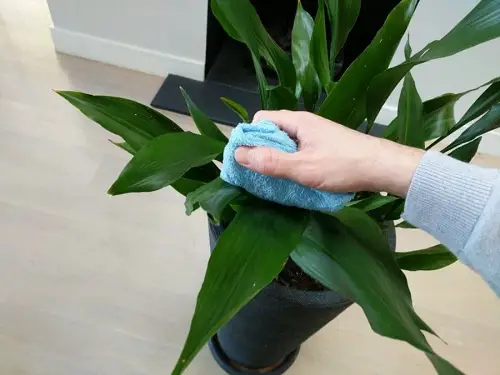
It’s a non-toxic, efficient, and straightforward way. So, if you have not developed this habit, now is the time to do so. Here is how to prepare the solution:
- A solution of lukewarm or room temperature water with mild soap or detergent can be used–mix a tablespoon of soap per gallon of water. Castile soap is the most effective, but you can also use insecticidal soap.
- Gently wipe down the leaves using a sponge soaked in the solution. You can also pour the solution into a spray bottle and use it.
- Weekly, apply this solution to treat the foliage until you completely get rid of the infestation. You can use it more frequently if you see positive results to counter the mites.
Tip: Some plants are very sensitive to soap solution, so check on a small portion of the leaf before trying the solution on the whole plant.
Check out these DIY mosquito-repellant candles here.
4. Use Plant-Based Miticides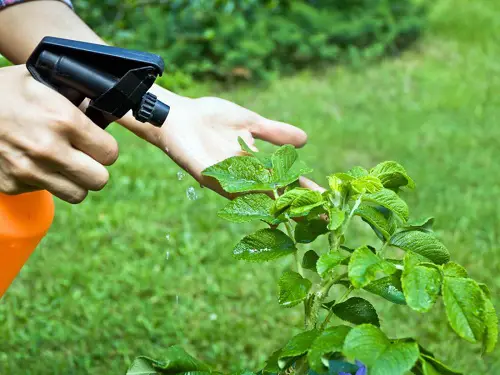
Miticides, which are plant-based, can be used to eliminate mites. Ensuring that they’ll only kill the mites but not harm other plants and insects in the vicinity. We have a list of such miticides here.
- Pyrethrum: A plant closely related to Chrysanthemum is used to produce this miticide. Although a very effective remedy, mites can develop resistance against so even if you use it, be observant.
- Cinnamite: Made from cinnamon oil, it is a nontoxic miticide and is environmentally friendly. Make sure you use it every three days. As it does not affect eggs, use it for two weeks so that not only adult mites but also hatchlings are exterminated.
- Neem oil: Obtained from the fruits and seeds of the neem tree, neem oil is an inexpensive way to prevent mites and other pests like powdery mildew and aphids; you can learn how to use it here.
- Rosemary oil: One great thing about rosemary oil is that it’ll only kill spider mites; it benefits humans and pets. Just mix it with water and spray it on the affected parts. Here is a study to support this claim.
Check out the organic ways to kill aphids here.
5. Spraying with Hose Sprayer
A high-velocity water jet can work wonders regarding mite infestation control. The blast of water from the hose end washes away the mites and dirt, and dust with it. As mites love to reside on the underside of the leaves, it’s essential to target the underside of the leaves.
6. Homemade Herbal Tea to Get Rid of Spider Mites
This herbal tea recipe is very effective in your mission of “How to Get Rid of Spider Mites,” and you can make it at home with a few ingredients:
- In a quart of water, mix one tablespoon of ground cloves, one tablespoon of ground cinnamon, and two tablespoons of Italian seasoning.
- Place the solution on a heater till it boils. Turn off the heat and let the solution cool off somewhat.
- Add two tablespoons of crushed garlic to the solution and let it cool off completely.
- Use a sieve to strain the solution into another bowl and add two drops of liquid dishwashing soap.
- Pour the solution into a sprayer and spray the underside of the leaves every three days. After a couple of times of applications, you’ll notice that mite infestation has gone down considerably.
Want to learn how to make organic insecticidal soap? Click here.
7. Using Organic Salts
Mites dislike fatty acids or potassium salts because of their rough texture. The abrasive surface of these substances is not suitable for their bodies. As the leaves should remain wet for an extended period to reach mites, it’s better to treat them late in the afternoon.
8. Keep Weeds in Check
Weeds not only take up space available for productive gardening but also provides shelter to many pests. Take away the shelter before mites start to breed there.
Not only the rooted weeds but you should also need to remove the debris from the garden. It includes plant stems, fallen leaves, and other parts of the plant body.
Find out some amazing natural pesticide recipes here.
9. Encourage Preying Insects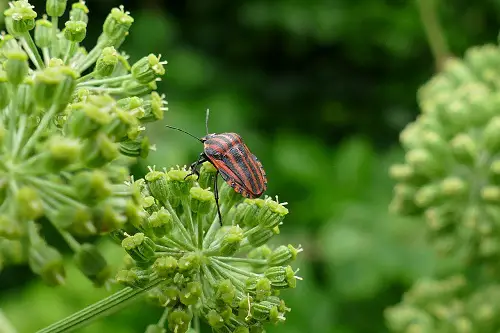
Some natural enemies of spider mites are ladybugs, lacewing larvae, and predacious thrips. But due to chemical pesticides, the population of such common insects decreases drastically. So, stop using pesticides excessively to sustain the predator-prey cycle and keep the mites population in check. It is a sustainable remedy to get rid of spider mites.
Carbaryl, malathion, and imidacloprid are among such harmful pesticides that you should steer clear of.
10. Use Neem Oil
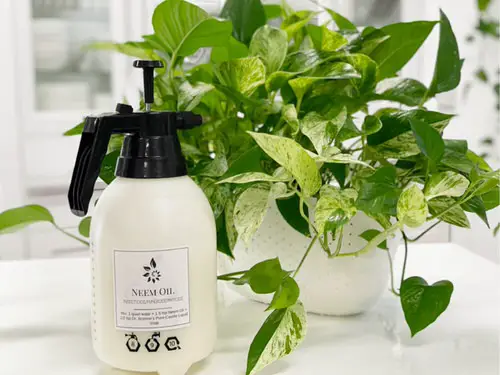
Use neem to kill spider mites. You can use the oil with water and apply it to the plant with a spray bottle or microfiber cloth and wipe it later. Make sure to apply this solution every 7 days. It is safe and natural, unlike chemical pesticides–learn more about neem oil uses here!
Do you know about the insects in your garden you should encourage? Know here
Treating Spider Mites With Chemicals
11. Apply Rubbing Alcohol
By using the alcohol on the underside of the affected plant, you can easily kill the mites. Use a clean cloth or cotton ball to pour a small amount of Isopropyl rubbing alcohol on it. Motion it on the infected leaves.
Learn about rubbing alcohol uses in the garden here
12. Use Proprietary Product
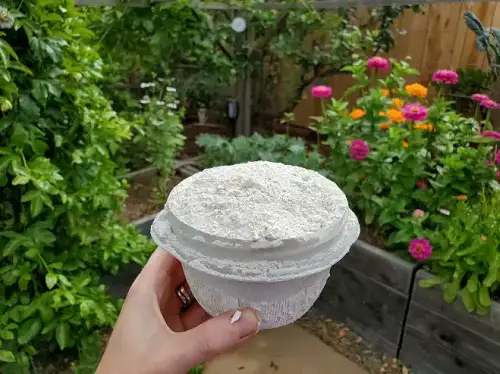
There are many proprietary products available in the market which are very effective against mites. Dienochlor, dicofol, azocyclotin, fenbutatin, and bromopropylate are some of the chemicals which constitute such products.
As spider mites might become resistant to such chemicals, do not use these products excessively. The instructions to use are given on the product’s label.
13. Using Liquid Sulfur
Sulfur is another effective remedy for spider mites, and it is used in its liquid form. The powdered sulfur will also work, but it can harm you if it gets into your eyes or if you breathe it in from the air.
Caveat: Do not use liquid sulfur in hot weather if the temperature is 90°F (32°C) or above, as it may burn the leaves.


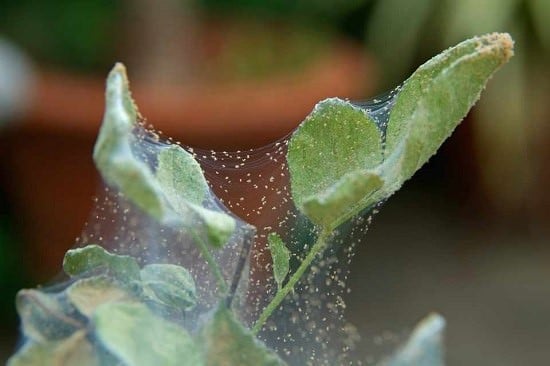


Pilea Peperomioides Chinese Money Plant has tiny black holes on some of the leaves, why?
Thank you.
Is this for *Balcony Gardening* as implied by the website name? So how are a bunch of these relevant?
Do a lot of people have hoses on their balconies?
Thanks for the great specific tip of using a “proprietary product” (eye roll)
Yes, Bob, they work. Some people need proprietary products because they can’t figure out how to deliver pressurized water to their balcony plants.